Hey, sorry for the delay. Here’s my late post! Please don’t let it make you miss Graeme’s awesomeness below, yeah?
I have to say: I’m very happy with the corner I’m painting myself into these days.
While I don’t feel especially burdened by the need in these posts to have “hot takes,” or review “current books,” or even pretend to know “what year it is,” there are times I’m aware giving you reviews of screamingly old comics, more or less chosen and read on a whim, and that may not be the best way to keep or attract a regular readership.
But you know what? I’m really happy doing this. Technically, I’m pretty sure last week’s capsule reviews were unbalanced—I’m not sure if I spent too much space on Sam Zabel and the Magic Pen, not quite enough space to really cover the charms and pitfalls of that book, or too little space on everything else—but boy did I enjoy reading them.
And so it is with this week’s read, even though it’s only one book and not a bunch. Join me after the jump, won’t you?
THE ADVENTURES OF RED SONJA, VOL. 1: A few weeks ago, I was kind of waxing nostalgic for Frank Thorne—you know, the way you idly do for something way back in your youth while you wait in line to order a sandwich or something—so, a day or two later, when this came up in that recent Dynamite sale on Comixology, I didn’t think twice.
While not the first artist to draw Red Sonja, Thorne was the artist who drew her from 1976 to 1979 when her solo book was on the stand. So his take is the one that feels iconic to me even though I ran hot and cold on his artwork, generally. Back then, I liked it most when comic art looked “clean,” which could mean a lot of different things but which I’m using here as a term for, uh, uncluttered, generic Marvel work: a lineage that runs from Sinnott inking Kirby, to John Romita, John Buscema and, way down the line of quality at about at the level I first encountered it, Sal Buscema.
I wasn’t a complete idiot, I should say: there were a lot of guys whose style didn’t fit into the generic Marvel house style whose work I still loved: Buckler, Starlin, Gulacy, Alcala, early Byrne (although all those guys are pretty slick), Colan, Kane, and others that’ll come to me five minutes after I hit the publish button.
But there were also artists whose work made me, for lack of a better term, anxious: Trimpe, Robbins, Kirby, Ploog, and—just to show you how incredibly skewed and narrow my comic reading was—Jim Mooney (albeit more for the stuff he ended up drawing for Steve Gerber than maybe how he drew it). Their work didn’t sit easily in the post-Romita house style. Because I was a Marvel fanatic, I bought it. I read it. But I wasn’t always sure I liked it.
And at the top of that uncertain list was Frank Thorne. His work was dirty. Not just in the sense of a generic house style but, really, in every sense. Rereading these first dozen issues of his Red Sonja stories (when they were still appearing in the short-lived second incarnation of Marvel Feature, a title so impressively generic and unimaginative title it’s barely a step above—although not as honest as —Marvel Product), I found it noteworthy how often Sonja ends up fighting in heavy rain, thick mud, and watery sewers, and a lot of the secondary characters drawn by Thorne have stringy hair, torn clothing, broken teeth.
For some reason, I always equated Thorne with Toth, probably because Thorne really uses heavy blacks to simultaneously create dramatic contrast and help guide the eye through the page. But rereading the digital collection, it became obvious from the way he whisks lines along the page to create texture Thorne had more in common with Kubert. And a huge comparison point to me is latter day Joe Orlando: his work (on that Alan Moore origin of The Phantom Stranger especially) and Thorne’s are kissing cousins. Pustuled, unwashed, inbred, kissing cousins.
And let’s not forget that other definition of the word dirty: Thorne clearly enjoyed drawing Red Sonja, a scantily clad warrior woman with a generous bosom, and he made sure he covered scenes from the the most salacious angles possible: in profile, Sonja was essentially nude from hip calf, and from behind her chainmail loincloth was no more than one link longer than it needed to be to stay appropriate. In fact, in some ways, Thorne was my introduction to the other side of comics, that darker side.
By which I mean…cosplay.
I’m not quite sure where or how I would’ve come across it as a kid, but somehow I saw a photo of Frank Thorne dressed as a wizard next to a woman dressed as Red Sonja. (You can see some, along with some amazing photos of Elfquest creator Wendy Pini cosplaying Red Sonja, here.) Thorne was born in 1930, so he was no spring chicken when he got the Red Sonja gig. Middle age being what it was back in the mid-70s, he looked about 110 years old in these photos. And to a kid—especially a young, judgey kid—like myself, the whole thing seemed suspect.
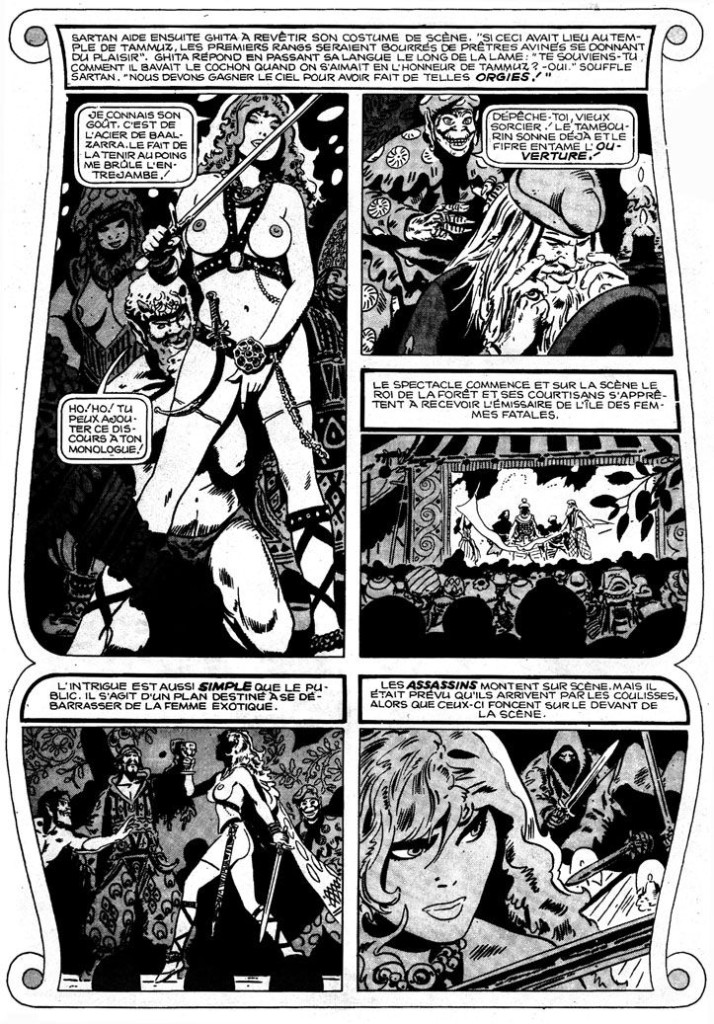 And by early 1980 or so, when I finally came across an issue of the Jim Warren mag 1984, featuring Thorne’s Red Sonja pastiche Ghita of Alizarr, those suspicions were confirmed. Oh sure, now fourteen year olds are waxing their genitalia, and snapchatting their perineum to all their friends, but back then we were a puritanical bunch (well, the ones not sniffing airplane glue and having sex with their yearbook teachers, anyway) and I was bummed out and mortified by the idea of a cartoonist clearly being turned on by the stuff he was drawing. (I was still about a year away from encountering Crumb, and nine years away from being able to appreciate him.) Like I said, due to how old I was and when, I had yet to see Crumb, had missed Wally Wood at his most satirically priapic. Frank Thorne was it, this darker side of comics, a glimpse at the guy on the other side of the drawing board, and he wasn’t some smiling, cigar-chomping Jack Kirby surrounded by a color wheel of masculine ideals. No, this was a dirty old man in a wizard outfit and the fact he was drawing forbidden stuff I was interested in peeking at drew an uncomfortably clear line of connection between the two of us.
And by early 1980 or so, when I finally came across an issue of the Jim Warren mag 1984, featuring Thorne’s Red Sonja pastiche Ghita of Alizarr, those suspicions were confirmed. Oh sure, now fourteen year olds are waxing their genitalia, and snapchatting their perineum to all their friends, but back then we were a puritanical bunch (well, the ones not sniffing airplane glue and having sex with their yearbook teachers, anyway) and I was bummed out and mortified by the idea of a cartoonist clearly being turned on by the stuff he was drawing. (I was still about a year away from encountering Crumb, and nine years away from being able to appreciate him.) Like I said, due to how old I was and when, I had yet to see Crumb, had missed Wally Wood at his most satirically priapic. Frank Thorne was it, this darker side of comics, a glimpse at the guy on the other side of the drawing board, and he wasn’t some smiling, cigar-chomping Jack Kirby surrounded by a color wheel of masculine ideals. No, this was a dirty old man in a wizard outfit and the fact he was drawing forbidden stuff I was interested in peeking at drew an uncomfortably clear line of connection between the two of us.
All of this, by the way, is the stuff I thought about while waiting for my lunch. And maybe it’s not this way for everyone but as I get older and more jaded, the more I find myself thinking about not only the stuff that attracted me in my youth, but the stuff that repelled me, too. Because now I’m old enough to realize how sometimes, like with Thorne’s art, there was a hot dot of attraction in all of that repulsion, and I find myself wondering if it was good or bad or if my repulsion was well-grounded or just teen self-loathing redirected outward.
And that brings me to this book.
At 137 pages, the collection is a bit light, though really only an issue or two fewer than what you’d get in the collection’s obvious inspiration, The Chronicles of Conan, Dark Horse’s recolored collections of the original Marvel material. And like that collection, you get a little essay from Roy Thomas on the creation of the issues involved. Here, in his introduction, Thomas points out something I’d either forgotten or never noticed: namely, that Bruce Jones scripted the first few Sonja stories Thorne drew.
I’ll be honest, I kind of have my issues with Jones—he could write great dialogue, but even though he often wrote about female protagonists, it always seemed to be done with one eye on the cheesecake. Thomas mostly praises his work in the intro (“Certain aspects of the story didn’t strike me as being quite as much in the Robert E. Howard vein as I wanted, but my quibbles were minor. I liked the stories, even if I was still planning to return [as writer] after a few issues.”). But I found myself reading stories that had fascinated me as a kid (“Balek Lives!”, “Eyes of the Gorgon” and “The Bear God Walks!”) and being bummed by how frequently Jones makes Sonja weakened or frightened, and how a rogueish love interest pops up to drive the plot and very nearly get into Sonja’s chainmail panties.
If you followed the Avengers readthrough Graeme and I did, you may remember I was more than a little appalled by the way Roy Thomas handled female characters: he was the epitome of the sixties progressive dude who wasn’t nearly as progressive as one would hope, with “liberated” being a synonym for “terrible” where women were concerned.
But happily, all of that is absent from Thomas’s stories and, in the wake of Jones, his handling of Sonja is just about everything one could hope for: gone are the lecherous male sidekicks; Sonja is hired by a priest who is only interested in her substantial skill with the sword, and when she runs up against supernatural enemies, her hackles are raised in exactly the same way Conan’s are—she’s about as far from immobilized with fear as you can get.
That said, it’s true that in Thomas’s stories, Sonja spends a certain amount of time very loosely fixated on Conan, thinking about him on her various long horse rides across Hyborian kingdoms. And, in the two issues of the Conan crossover that conclude this book (that, audaciously, Dynamite doesn’t actually finish, leaving you with a cliffhanger that requires the purchase of another volume to resolve), Bêlit, Conan’s paramour, spends a lot of time jealously calling Sonja a “Hyrkanian harridan” and like that. I liked these stories so much more that I would’ve immediately picked up Volume II…if it wasn’t currently almost twenty bucks for another mere seven issues.
And as for Frank Thorne, the subject of all my pre-sandwich speculation? He’s actually pretty terrific in this volume. Maybe it says something sad about where comics have gone in decades since, but sexualized though his Red Sonja may be, you never get anything close to the talking ass-shots so prevalent in comics after Liefeld and Lee came to town. There’s no reaction shots pulled from porn actors. Also, I feel awkward mentioning this, but having a character with big breasts that are actually drawn the way big breasts work in real life (hint: gravity is involved) makes it feel less like an objectifying fantasy to me.
I don’t know, maybe it’s just an objectifying fantasy by someone who’s great with anatomy? It’s obviously a long way from a Red Sonja realistic enough to complain, even if only to herself, about back aches and discomfort running (or even that Dave Sim joke about the chainmail bikini), but I think it makes the ’70s Red Sonja much closer to a female heroine women can appreciate without a lot of psychic compromises than one would think. Seeing Thorne’s Ghita material, it’s clear he was interested in the erotic side of a scantily clad warrior woman, but here at least he doesn’t stunt on making her believably athletic and strong and resilient.
Also, there’s some really great storytelling on display. My favorite is a page from a Jones issue where Thorne employs a series of inset panels to act as a zoom to close-in on a character’s face, followed immediately by a giant automaton coming to life in another trio of close inset panels, only for the mechanism to “come alive” and fully turn out of the third panel and into a looming over the shoulder shot.
But a close runner-up is a fabulous panel of Sonja stabbing a crocodile beast in the head: Thorne draws three versions of the arm in the act of driving the knife home, almost like one of Gene Colan’s multiple exposure movement panels. But the way Thorne set up the page flow, the reader’s eye is guided so smoothly along those panels what you actually get is the feeling in film of slow motion transitioning back to regular speed.
And, yeah, the people are grotty and smelly-looking and bestial, and it all looks like the kind of surroundings where disease is rampant…but shouldn’t it?
No, for my money, Frank Thorne—that old cosplaying perv—more than passes muster in the end. Instead of just childish repulsion, I have an adult appreciation. They’re certainly not anything I’ll be passing along to my niece anytime soon (although I think she’d love to see a woman with a sword killing monsters) but I hope they find their audience. He may have been a dirty old man, but in some ways Frank Thorne was also ahead of his time. It’d be nice to imagine a place for his past in our future.
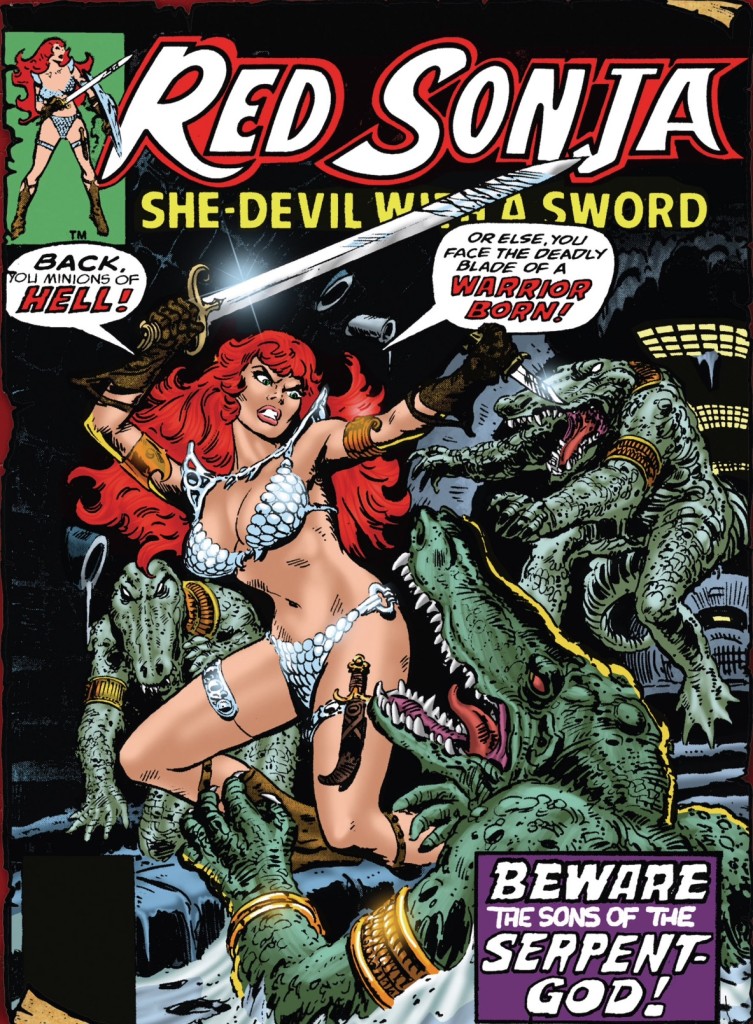
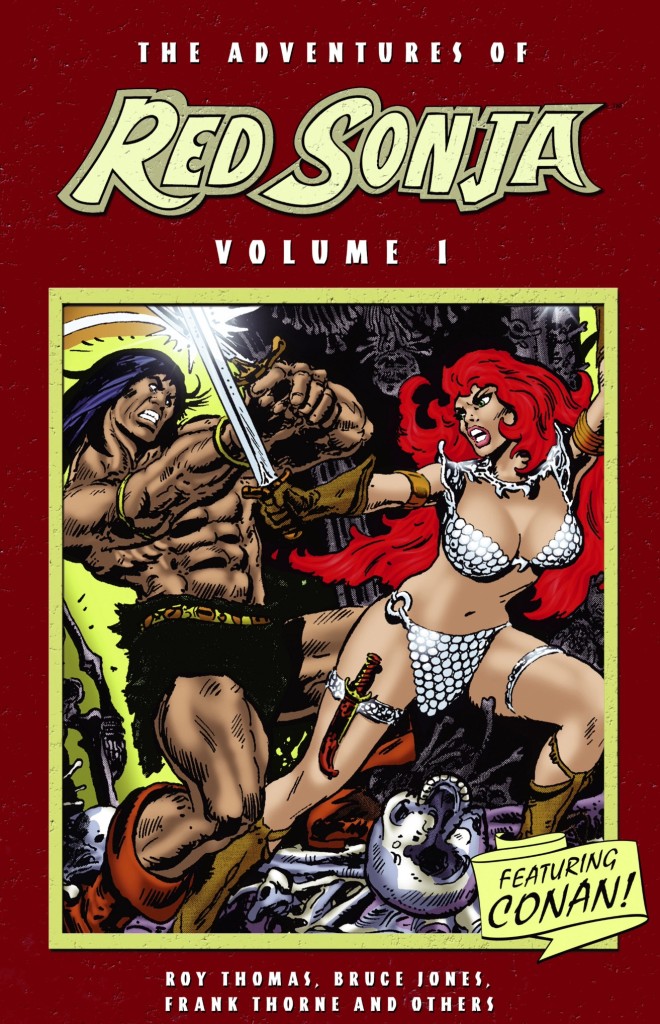


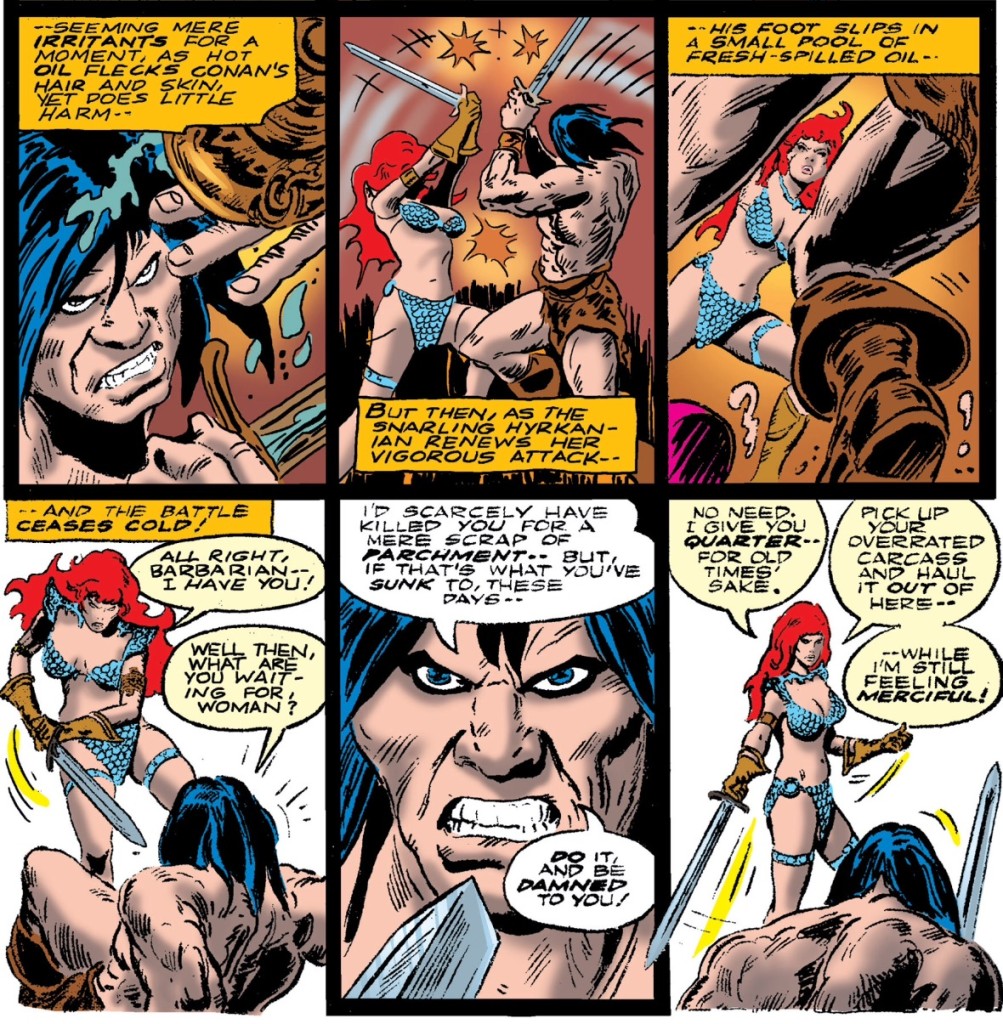
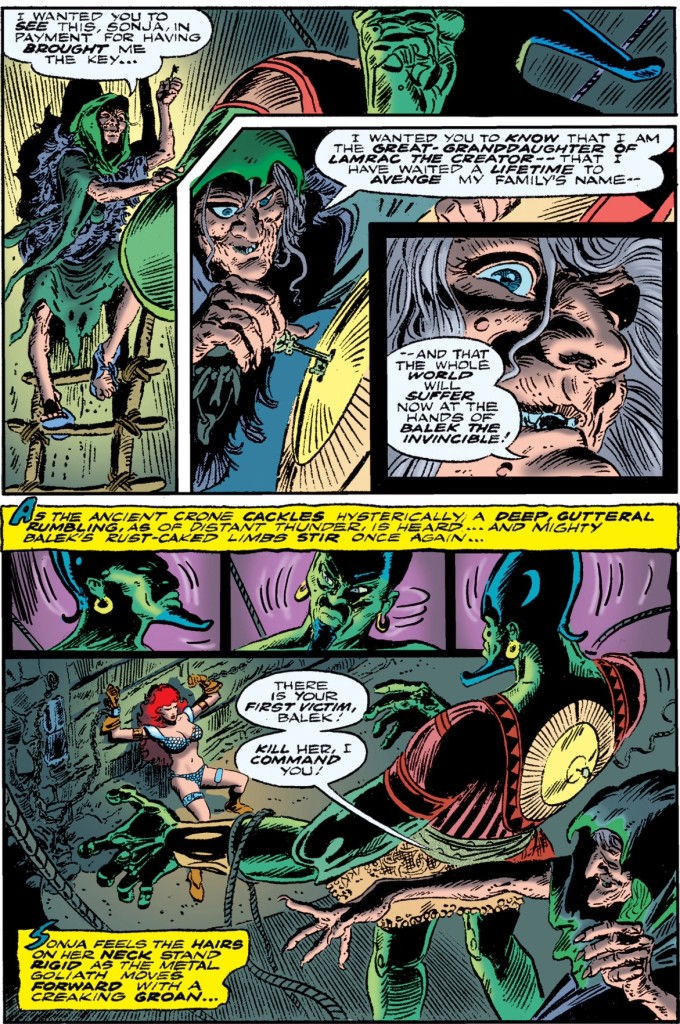
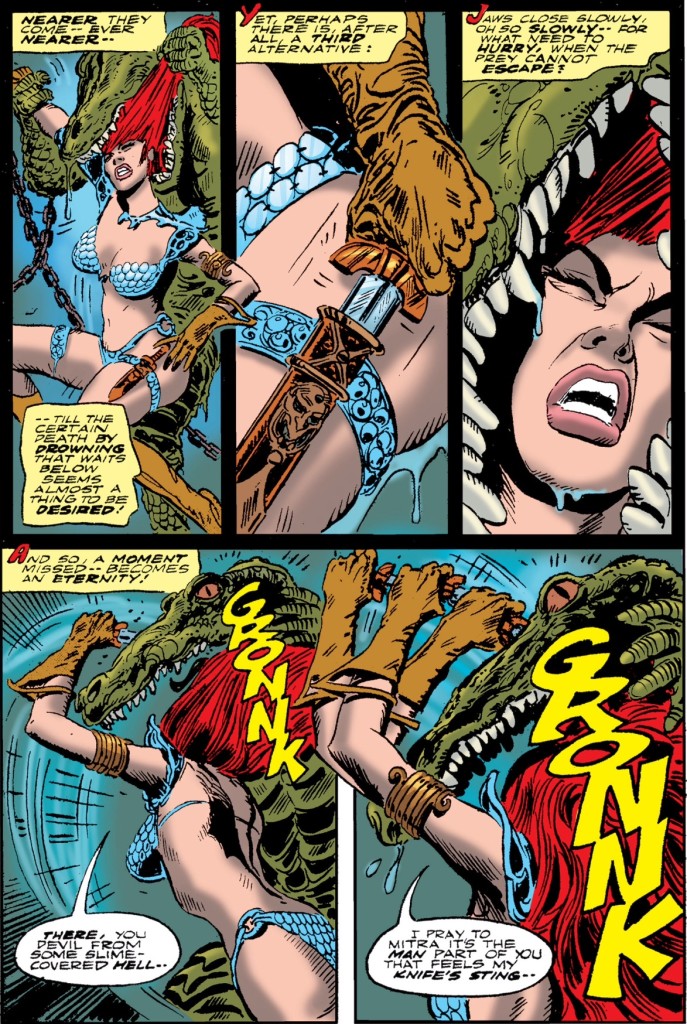


After Thorne moved on, Red Sonja swapped the chainmail bikini for a variety of other clothes, changing from story to story – and so it remained until the Dynamite series, where the chainmail bikini returned as her regular duds.
My question: why is it that Conan can wear anything and still be Conan (ie, he need not wear the horned helmet from the initial BWS issues), but Red Sonja *must* have an official “costume?”
It’s funny: maybe because I came to Conan late and so I don’t think of the horned helmet as necessary, but I’m always wary if he’s not loinclothed. No pants for Conan!
[Edited to add a missing word that hoo-boy made this reply read very interestingly otherwise.]
I always thought of Conan’s costume as “long haired and usually shirtless.” I look for that much consistency, just as I look for Sonja to be in some kind of chain mail (I’m quite happy when it’s not the bikini, but something a bit more functional.)
Jeff, first let me say I for one love these random reviews of older material. Probably because I tend to split my time reading comics between older and brandy new books. I like the variety. Also because I too am borderline obsessed with examining what I liked and why and do I still I like it now. Trust me I spend time in sandwich lines thinking these same things. So keep up the older book reviews whenever you like; I’ll always enjoy reading them.
Second I now wish I’d sprung for this Red Sonja collection when the comixology sale happened. It looks fun. Thorne does draw some great action scenes in the examples you showed here. And those pics of him you linked to?? Outrageous, as Aquaman would say. I especially got a kick out of the one at his drawing table with his mostly naked “publisher” hanging over his shoulder. Yikes Frank.
Third I just laughed out loud when you described modern comics artists’ habit of employing the talking ass shot because I just read through a chunk of Dwayne Mcduffie’s Justice Leauge run ( thank you public library!) and in it Ed Benes is extremely fond of the talking ass shot. I noted that for a stretch it seemed Black Canary’s butt was the most prominent element in at least two panels per page. At least two usually more! And Vixen’s butt starred in a helluva lot of talking ass shots too. But Canary seemed to appear as a talking ass only for issues at a time. We see her butt more than face. Benes draws a fine Canary butt but yeesh it was so obvious it took me right out of the book quite often. So yeah. Guys like Thorne were a wee bit more subtle in their unsubtle cheesecake poses I suppose?
Great post!
Thanks so much for the comments, Michael! It’s good to know someone else is digging these kinds of posts. And I almost referred to Ed Benes by name before deciding not to! So you definitely know the kind of shot I’m talking about. Like you said, guys like Thorne were just a bit more subtle, but it makes a lot of difference.
Finally, I counsel patience: it’s rare for Dynamite to give buyers only one shot at a book and with the holidays, Black Friday, etc., coming up, I’d like to think you’ll get another shot at it. Meanwhile, I’m trying to figure out how long I can hold out for Vol. 2 which is priced at almost $20!
Comixology sales are really tempting of late, Jeff. I see the Paul Dini Zatanna run is on sale at the moment…so tempted to scoop that one up. My problem is I have so many books yet to read both digitally and in hard copy that I’m damn near overwhelmed by them all. As you can relate to from your own experiences! I went crazy at the library this week and snagged so many books, which only made my predicament worse (or better depending on how you look at it – these are first world problems after all!).
That’s such a bummer on Red Sonja vol 2 being priced so high! I’m really digging the Thorne art here.
So Zatanna now, maybe Red Sonja later….I have so little will power.
Congratulations, fellow weak-willed digital shopper! The Frank Thorne Red Sonjas are on sale this weekend: http://tinyurl.com/puja29z. I was hoping they’d go on sale at some point, but I was not expecting it to be this soon.
Ha! I scooped up the first two volumes. Weak-willed digital shoppers unite!